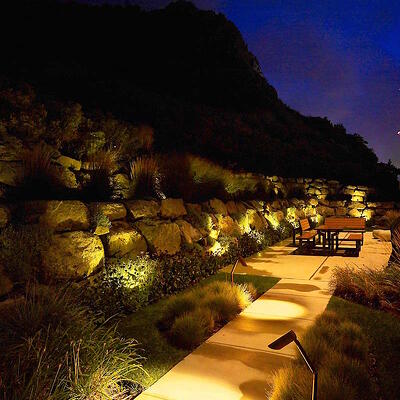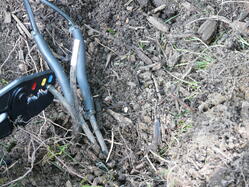120V vs. 12V: Which is the Safer Landscape Lighting Option?

While our end goal is beautiful, artistic outdoor landscape lighting, safety is among our top concerns.
How do we safely get the electricity to your outdoor landscape lighting?
There are two voltage choices for outdoor lighting: 120V vs. 12V.
Let’s take a look at which is the safest option.
First, What’s The Difference?
120V is known as high voltage, line voltage or standard voltage. This is the voltage that comes directly into most homes. In most municipalities, a licensed electrician is required to make all 120V connections.
12V, known as low voltage lighting, uses a step-down transformer to change your home’s 120V electrical supply to 12V.
This conversion makes your lighting system safe to install and maintain, since the voltage level is significantly lower than a standard electrical outlet.
The Safest Voltage For Residential Landscape Lighting
Hands down, 12V is the safest option to power your residential landscape lighting.
Exposure to 120V can kill a person. That’s a huge electrical current. Exposure to the much lower 12V will give just a slight shock if you or a family member come into contact with it.
Other Benefits Of 12V
Beyond safety, there are other benefits to using 12V over 120V for your landscape lighting. They range from better light control to longevity to better efficiency.
12V Offers Better Light Control
120V is very limited in fixture selection and quality of light output.
But 12V offers a huge array of wattages, color temperatures, and beam spreads. With 12V, I have every color in the rainbow for our light artistry. With 120V, I have about three colors.
12V Lasts Longer
Longevity is another big issue. 120V just doesn’t hold up like 12V does. 12V light bulbs generally last longer than 120V due to the greater heat generated during operation of 120V.
12V Is More Energy Efficient
Low voltage systems are more energy efficient than 120V systems. They typically use 20 to 40 percent less electricity than 120V, and that savings is even higher if you use LED lighting.
12V Is Easier To Relocate
It’s easier for a landscape lighting professional to move fixtures installed with 12V than with 120V if you decide to change your landscape or when your plants grow and change.
A Word About Connectors

Any discussion about electrical safety should include a note about the importance of the right connectors. The connections between your lighting fixtures and the wiring that runs to your power source must be tight.
Poor quality connectors will fail over time, which could mean a short, meltdown of the wiring or even a fire.
At Landscape Lighting Pro of Utah, we use only the highest quality, watertight, heat-shrink connectors to connect your lighting fixtures to the wiring that runs to the power source. They resist corrosion and stay secure.
Other landscape lighting systems may use wire nuts and pierce connectors, which aren’t designed to go underground. Pierce point connections to the main line tend to loosen and corrode, posing a safety risk.
When 120V Is A Better Option
120V outdoor lighting is most often used in commercial or security situations, when there’s a need to light large areas with a lot of light output.
But for residential landscape lighting, 12V is definitely the safer, better choice.
Give Us A Call
To learn more about outdoor lighting in your landscape, call (801) 440-7647 to schedule a free consultation, or fill out our simple contact form.
Located in Sandy, Landscape Lighting Pro of Utah serves customers throughout Utah’s residential areas, including Salt Lake City, Park City, Draper and Holladay. Our outdoor lighting portfolio includes projects from Salt Lake County and Utah County, to Davis County and Summit County — and beyond.
Salt Lake City (Midvale)
801-440-7647
St. George
435-932-6627
©2025 Landscape Lighting Pro
Privacy Policy
Cookie Policy